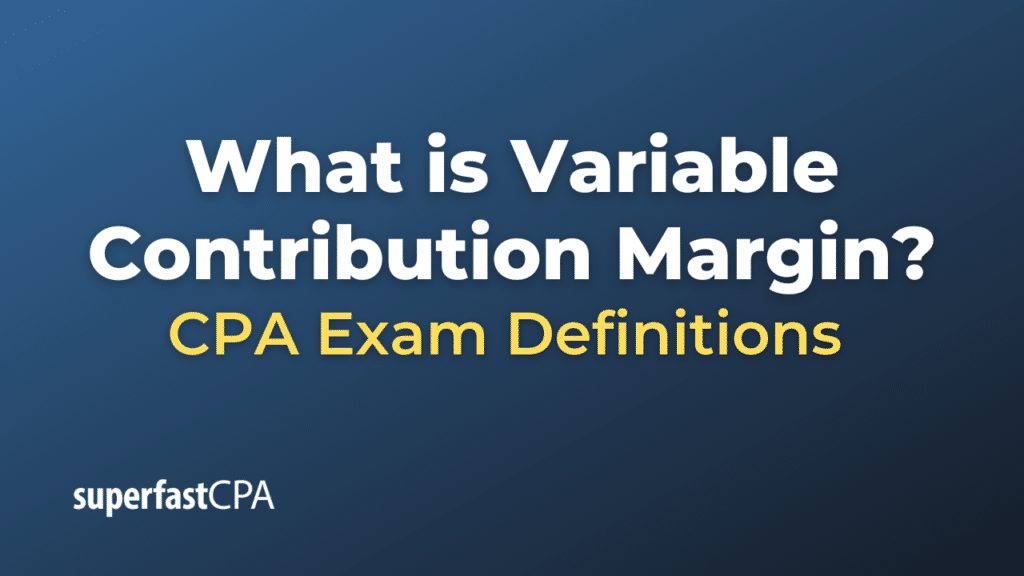Variable Contribution Margin
The Variable Contribution Margin refers to the revenue remaining per unit after subtracting the variable costs that go into producing a product. In other words, it is the contribution each unit of a product makes to cover fixed costs and generate profit. This metric is particularly useful for understanding the profitability of individual items sold by a business.
The formula for calculating the Variable Contribution Margin per unit is:
Variable Contribution Margin per Unit = Selling Price per Unit − Variable Cost per Unit
The Variable Contribution Margin Ratio, expressed as a percentage, is calculated as follows:
Variable Contribution Margin Ratio = (Variable Contribution Margin per Unit / Selling Price per Unit) × 100
Importance of Variable Contribution Margin:
- Profitability Analysis: It helps businesses determine the profitability of individual products.
- Pricing Strategies: Understanding the contribution margin can help in setting the right pricing strategies.
- Break-Even Analysis: It is crucial for calculating the break-even point, i.e., the point at which total revenue equals total costs.
- Cost Control: Identifying the variable costs associated with production can lead to cost-saving measures.
- Resource Allocation: Businesses can focus resources on products with higher contribution margins to maximize profitability.
Example of Variable Contribution Margin
Let’s delve into an example that illustrates the concept of Variable Contribution Margin using a fictional bakery called “Sweet Treats.”
Business Context:
Sweet Treats offers a variety of baked goods but is especially known for its chocolate chip cookies. The bakery is trying to optimize its operations and wants to understand how profitable its cookies are.
Financial Details (per cookie):
- Selling Price: $2.00
- Variable Costs (flour, sugar, chocolate chips, labor): $0.80
Calculating the Variable Contribution Margin:
- Variable Contribution Margin per Cookie:
Selling Price per Cookie − Variable Cost per Cookie
$2.00 – $0.80 = $1.20
Each cookie contributes $1.20 towards covering the fixed costs and generating a profit. - Variable Contribution Margin Ratio:
(Variable Contribution Margin per Cookie / Selling Price per Cookie) × 100
(1.20 / 2.00) × 100 = 60%
Interpretation:
- Profitability: The Variable Contribution Margin of $1.20 per cookie indicates that this amount can go towards covering fixed costs like rent, utilities, and salaries, as well as generating profit for the business.
- Margin Ratio: A Variable Contribution Margin Ratio of 60% means that 60% of the revenue from each cookie sale can be used to cover fixed costs and generate profit.
Business Decisions:
Understanding that each cookie has a Variable Contribution Margin of $1.20 and a Margin Ratio of 60% can guide Sweet Treats in several ways:
- Pricing Strategy: If the bakery wants to offer a discount to attract more customers, knowing the Variable Contribution Margin ensures they don’t set a selling price that falls below the variable costs.
- Promotions: During special events, Sweet Treats can focus on marketing the cookies, knowing they have a high contribution margin.
- Cost Control : Understanding that the variable cost per cookie is $0.80 can help in negotiating better deals with suppliers or optimizing production to bring this cost down, thereby increasing the contribution margin.
- Resource Allocation: Knowing the contribution margin can guide the bakery on where to allocate resources, perhaps favoring cookies over less profitable items.
This example demonstrates how Variable Contribution Margin is a useful metric in business decision-making, helping to focus efforts on the most profitable activities and make informed pricing and promotional strategies.












